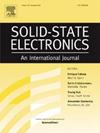1.2 kV 4H-SiC mosfet在重复短路试验下的静态和动态特性退化机制
IF 1.4
4区 物理与天体物理
Q3 ENGINEERING, ELECTRICAL & ELECTRONIC
引用次数: 0
摘要
本文分别在- 4/+15 V、- 4/+19 V和0/+19 V的关断和通断栅源电压(VGS、OFF/VGS、ON)下进行重复短路(RSC)试验,研究1.2 kV 4H-SiC mosfet的退化行为。结合实验和仿真结果,发现雪崩过程中栅极氧化物中的捕获电子或空穴是静态参数的主要退化机制。这导致VTH和RDS分别增加0.4 V和3.0 mΩ,在VGS,OFF/VGS,ON =−4/+19 V;0.45 V和4.1 mΩ在VGS,OFF/VGS,ON = 0/+19 V;在VGS、OFF/VGS、ON =−4/+15 V条件下,240短路(SC)试验降低0.69 V和3.2 mΩ。被测器件的动态特性,包括CGS、CDS、CGD也会下降。在JFET区域上方的栅极氧化物中捕获的空穴导致损耗区变薄,CGD明显增加。此外,高反向栅极偏压下的栅极泄漏电流受RSC测试的影响,主要是由于捕获电子通过缺陷态跃迁到多si /SiO2界面。本文章由计算机程序翻译,如有差异,请以英文原文为准。
Degradation mechanisms for static and dynamic characteristics in 1.2 kV 4H-SiC MOSFETs under repetitive short-circuit tests
In this paper, repetitive short-circuit (RSC) tests are conducted at off-state and on-state gate-source voltages (VGS,OFF/VGS,ON) of −4/+15 V, −4/+19 V and 0/+19 V, respectively, to investigate the degradation behaviors of 1.2 kV 4H-SiC MOSFETs. Combining experimental and simulation results, it is found that trapped electrons or holes in the gate oxide during the avalanche process are the main degradation mechanism for the static parameters. This results in increases of 0.4 V and 3.0 mΩ in VTH and RDS,ON, respectively, at VGS,OFF/VGS,ON = −4/+19 V; 0.45 V and 4.1 mΩ at VGS,OFF/VGS,ON = 0/+19 V; and decreases of 0.69 V and 3.2 mΩ at VGS,OFF/VGS,ON = −4/+15 V after 240 short-circuit (SC) tests. The dynamic characteristics of the device under test, including CGS, CDS, CGD also degrade. The trapped holes in the gate oxide above the JFET region lead to a thinner depletion region and an obvious increase in CGD. Furthermore, the gate leakage current under high reverse gate bias is affected by the RSC tests, primarily attributed to trapped electrons hopping to the poly-Si/SiO2 interface via defect states.
求助全文
通过发布文献求助,成功后即可免费获取论文全文。
去求助
来源期刊

Solid-state Electronics
物理-工程:电子与电气
CiteScore
3.00
自引率
5.90%
发文量
212
审稿时长
3 months
期刊介绍:
It is the aim of this journal to bring together in one publication outstanding papers reporting new and original work in the following areas: (1) applications of solid-state physics and technology to electronics and optoelectronics, including theory and device design; (2) optical, electrical, morphological characterization techniques and parameter extraction of devices; (3) fabrication of semiconductor devices, and also device-related materials growth, measurement and evaluation; (4) the physics and modeling of submicron and nanoscale microelectronic and optoelectronic devices, including processing, measurement, and performance evaluation; (5) applications of numerical methods to the modeling and simulation of solid-state devices and processes; and (6) nanoscale electronic and optoelectronic devices, photovoltaics, sensors, and MEMS based on semiconductor and alternative electronic materials; (7) synthesis and electrooptical properties of materials for novel devices.
 求助内容:
求助内容: 应助结果提醒方式:
应助结果提醒方式:


